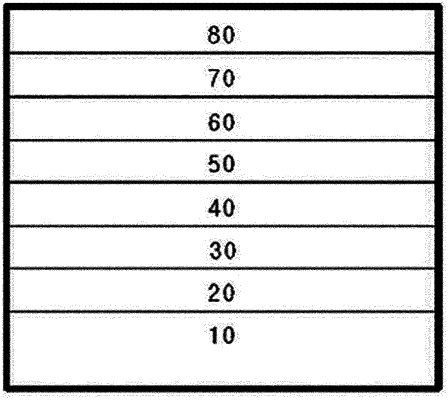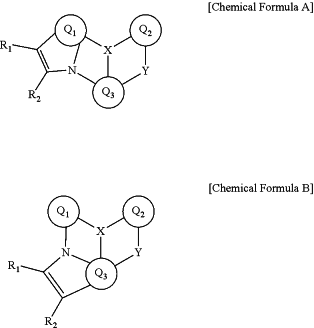| CPC C07F 5/02 (2013.01) [G09F 9/301 (2013.01); H10K 85/622 (2023.02); H10K 85/626 (2023.02); H10K 85/636 (2023.02); H10K 85/6572 (2023.02); H10K 85/6574 (2023.02); H10K 85/6576 (2023.02); H10K 50/11 (2023.02)] | 20 Claims |

|
1. A boron compound represented by the following Chemical Formula A or B:
 wherein,
Q1 to Q3, which are same or different, are each independently a substituted or unsubstituted aromatic hydrocarbon ring of 6 to 50 carbon atoms, or a substituted or unsubstituted heteroaromatic ring of 2 to 50 carbon atoms,
Y is any one selected from N—R3, CR4R5, O, and S,
X is, and
R1 to R5, which are same or different, are each independently any one selected from a hydrogen atom, a deuterium, a substituted or unsubstituted alkyl of 1 to 30 carbon atoms, a substituted or unsubstituted aryl of 6 to 50 carbon atoms, a substituted or unsubstituted cycloalkyl of 3 to 30 carbon atoms, a substituted or unsubstituted heteroaryl of 2 to 50 carbon atoms, a substituted or unsubstituted alkoxy of 1 to 30 carbon atoms, a substituted or unsubstituted aryloxy of 6 to 30 carbon atoms, a substituted or unsubstituted alkylthioxy of 1 to 30 carbon atoms, a substituted or unsubstituted arylthioxy of 5 to 30 carbon atoms, a substituted or unsubstituted alkylamine of 1 to 30 carbon atoms, a substituted or unsubstituted arylamine of 5 to 30 carbon atoms, a substituted or unsubstituted alkylsilyl of 1 to 30 carbon atoms, a substituted or unsubstituted arylsilyl of 5 to 30 carbon atoms, a nitro, a cyano, and a halogen,
R3 to R5 can each be connected to the Q2 ring moiety or Q3 ring moiety to form an additional mono- or polycyclic aliphatic or aromatic ring and
R4 and R5 can be connected to each other to form an additional mono- or polycyclic aliphatic or aromatic ring,
wherein, the term ‘substituted in the expression “substituted or unsubstituted” used for compounds of Chemical Formulas A and B means having at least one substituent selected from the group consisting of a deuterium atom, a cyano, a halogen, a nitro, an alkyl of 1 to 24 carbon atoms, an aryl of 6 to 24 carbon atoms, an arylalkyl of 7 to 24 carbon atoms, an alkylaryl of 7 to 24 carbon atoms, a heteroaryl of 2 to 50 carbon atoms, a heteroarylalkyl of 2 to 24 carbon atoms, an alkoxy of 1 to 24 carbon atoms, an alkylamino of 1 to 24 carbon atoms, an arylamino of 6 to 24 carbon atoms, a heteroarylamino of 1 to 24 carbon atoms, an alkylsilyl of 1 to 24 carbon atoms, and an arylsilyl of 6 to 24 carbon atoms.
|